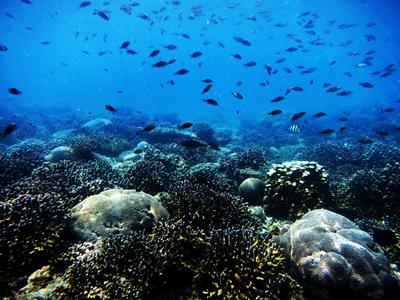Surviving harsh environments becomes a death-trap for specialist corals

Researchers from the Ocean and Earth Science at the University of Southampton and the New York University Abu Dhabi have found that local adaptation to high salinity levels in the southern Persian/Arabian Gulf (PAG) may prevent coral escaping their fate, as they lose their superior heat tolerance in waters with normal salinity levels.
The success of corals that adapt to survive in the world’s hottest sea could contribute to their demise through global warming, according to new research. The research is published this week in The ISME Journal, a world leading publication platform for ecological research, from where it can be freely accessed via Nature
Warm water corals depend on a vital partnership with unicellular algae of the genus Symbiodinium. Damage to the algal symbiont through heat stress can result in the breakdown of the association, leading to fatal coral bleaching. Most corals fall victim to bleaching at water temperatures above 32ºC. However, corals from the PAG region survive summer peak temperatures of up to 35ºC on a regular basis.
Senior author of the study, Professor Jörg Wiedenmann from Ocean and Earth Science at the University of Southampton, explains: “It was not clear whether this resilience is related to the presence of a new type of symbiotic alga (Symbiodinium thermophilum) that was recently discovered by our team in this region. Therefore, we used molecular markers to identify the algal partners of three coral species along the coast of the southern Gulf and the adjacent Gulf of Oman. We found that this special symbiont indeed seems to play an integral role for coral survival in the world’s hottest sea.”
The researchers studied corals along 1,000km of coastline in the southern PAG, a region where the world’s warmest coral reef habitats are separated from the wider Indian Ocean by the narrow Strait of Hormuz. Notably, the PAG features not only record temperatures, but the water is also exceptionally salty.
Professor Wiedenmann, who runs the University’s Coral Reef Laboratory based at the National Oceanography Centre Southampton, continues: “As soon as you leave the Gulf, corals start to host different symbionts. This ‘partner exchange’ starts when the salinity of the water approaches normal oceanic levels.”
Lead-author Dr Cecilia D’Angelo, Senior Research Fellow at the University of Southampton, says: “We have simulated these conditions in our laboratory and found that corals from the Gulf lose their exceptional heat stress tolerance when they need to cope at the same time with salinity levels commonly found in coral reefs elsewhere. This may explain why the PAG-typical coral-alga associations are rarely found in the less salty water or the Gulf of Oman.”
Dr D’Angelo adds: “Some corals may potentially escape their fate in waters heated by global warming by shifting their geographic distribution. However, our findings indicate that in addition to barriers such as landmasses, the lack of suitable substrate for settlement and adverse currents, the dependence on certain local environmental conditions may represent an invisible fence that could trap corals in their endangered habitat.”
With rising ocean temperatures anticipated to cause a loss of most warm water reefs within the next 100 years, it has been discussed whether heat tolerant corals adapted to hot environments, such as PAG, could be used to replenish reefs damaged by global warming elsewhere.
Professor Wiedenmann comments: “Our results suggest that the transplantation of corals over large geographic distances is not a straight-forward solution to restore reefs since they may struggle to adjust to different environmental factors apart from the temperature in the new habitat. Efforts to protect coral reefs should rather focus on other measures including the reduction of nutrient enrichment, sedimentation, overfishing and destructive coastal development. At the same time all attempts should be made to reduce CO2 emissions to prevent further global warming.”
The study was funded by the Natural Environment Research Council (NERC), the European Research Council under the European Union's Seventh Framework Programme and by a GSNOCS-CASE studentship.
REFERENCES
Cecilia D’Angelo, Benjamin C.C. Hume, John Burt, Edward G. Smith, Eric P. Achterberg and Jörg Wiedenmann (2015). Local adaptation constrains the distribution potential of heat-tolerant Symbiodinium from the Persian/Arabian Gulf. The ISME Journal, DOI 10.1038/ismej.2015.80
Free download: http://www.nature.com/ismej/journal/vaop/ncurrent/full/ismej201580a.html
Hume, B.C.C. et al. Symbiodinium thermophilum sp. nov., a thermotolerant symbiotic alga prevalent in corals of the world’s hottest sea, the Persian/Arabian Gulf. Sci. Rep. 5, 8562; DOI:10.1038/srep08562 (2015).
Free download: http://www.nature.com/srep/2015/150224/srep08562/full/srep08562.html
D’Angelo, C. and Wiedenmann, J. "Impacts of Nutrient Enrichment on Coral Reefs: New Perspectives and Implications for Coastal Management and Reef Survival." Current Opinion in Environmental Sustainability 7, (2014): 82-93.
Free download: http://www.sciencedirect.com/science/article/pii/S1877343513001917
What's related
Notes for editors
1. The attached image shows coral in the South Arabian Gulf. Further high resolution images and video with commentaries on the research, along with the raw interview files, can be downloaded here: https://www.dropbox.com/sh/r8df7m915y0q779/AABYEzTFko5jVMizZE_6ZSdqa?dl=0
2. The paper ‘Local adaptation constrains the distribution potential of heat-tolerant Symbiodinium from the Persian/Arabian Gulf’ by Cecilia D’Angelo, Benjamin C.C. Hume, John Burt, Edward G. Smith, Eric P. Achterberg and Jörg Wiedenmann (2015) is published in the ISME Journal, DOI 10.1038/ismej.2015.80 http://www.nature.com/ismej/journal/vaop/ncurrent/full/ismej201580a.html A copy is also available from Media Relations on request.
3. For more information about the Coral Reef Laboratory of the University of Southampton, based at the National Oceanography Centre Southampton: http://noc.ac.uk/corals
4. Ocean and Earth Science at the University of Southampton has reaffirmed its position as a world-leader in research excellence following publication of the national Research Excellence Framework 2014 (REF2014). https://www.southampton.ac.uk/oes/news/2014/12/ocean_and_earth_science_at_southampton_once_again_ranked_world_leading.page?
Follow us @OceanEarthUoS
Follw us @TheCoralReefLab